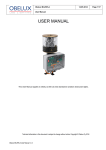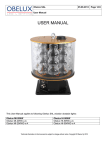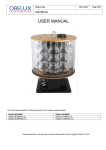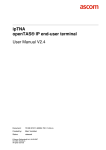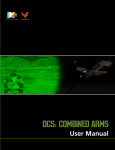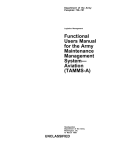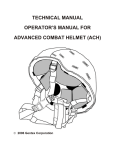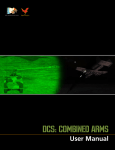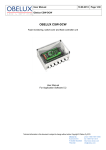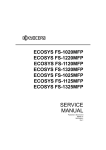Download file
Transcript
Obelux MI-2KR-A 04.06.2014 User Manual USER MANUAL This User Manual applies to Obelux 2.000 cd (red) standalone aviation obstruction lights with software version 3.0 or above. Technical information in this document is subject to change without notice. Copyright © Obelux Oy 2014 Obelux MI-2KR-A User Manual v1.4 Page 1/17 Obelux MI-2KR-A 04.06.2014 Page 2/17 User Manual Table of contents 1 Overview ................................................................................................................................................................... 3 2 Models ...................................................................................................................................................................... 3 3 Options ..................................................................................................................................................................... 4 4 Mounting sets ........................................................................................................................................................... 4 5 Dimensions ............................................................................................................................................................... 4 5.1 Horizontal mounting set .................................................................................................................................... 5 5.2 Plate mounting set............................................................................................................................................. 5 5.3 Vertical mounting set ......................................................................................................................................... 6 6 Parts ......................................................................................................................................................................... 6 7 Options ..................................................................................................................................................................... 7 7.1 Ethernet/IP network ........................................................................................................................................... 7 7.2 GPS ................................................................................................................................................................... 8 7.3 Infrared .............................................................................................................................................................. 8 8 Installation ................................................................................................................................................................ 8 8.1 Verify model ...................................................................................................................................................... 8 8.2 Configuration ..................................................................................................................................................... 9 8.2.1 Light head type .......................................................................................................................................... 9 8.2.2 Flash rate .................................................................................................................................................. 9 8.2.3 Photocell .................................................................................................................................................. 10 8.2.4 Device mode ........................................................................................................................................... 10 8.2.5 Reserved setting ..................................................................................................................................... 10 8.3 Mounting .......................................................................................................................................................... 11 8.3.1 Physical installation ................................................................................................................................. 11 8.3.2 Alarm relay .............................................................................................................................................. 11 8.3.3 Using with DC power supply ................................................................................................................... 11 8.3.4 Wiring ...................................................................................................................................................... 11 8.3.5 Connectors - Mains power in and Mains power out ................................................................................ 12 8.3.6 Connectors - Grounding .......................................................................................................................... 12 8.3.7 Connectors – Alarm and RS-485 ............................................................................................................ 13 8.3.8 Post-installation actions .......................................................................................................................... 14 8.3.9 Power-On ................................................................................................................................................ 14 9 Status indications ................................................................................................................................................... 14 10 Causes for ALARM ................................................................................................................................................. 15 11 Troubleshooting ...................................................................................................................................................... 15 11.1 Troubleshooting GPS (if installed) .................................................................................................................. 15 12 Spare parts ............................................................................................................................................................. 15 13 Configuration sheet ................................................................................................................................................ 16 14 Change log ............................................................................................................................................................. 17 Technical information in this document is subject to change without notice. Copyright © Obelux Oy 2014 Obelux Oy phone +358 9 6871 6800 Kutomotie 6 B fax +358 9 621 5518 FI-00380 http://www.obelux.com Obelux MI-2KR-A User Manual v1.4 FINLAND [email protected] HELSINKI Obelux MI-2KR-A 04.06.2014 Page 3/17 User Manual 1 Overview Obelux MI-2KRx-A is aviation obstruction light product to customers needing an obstruction light that provides 2 000 cd red and infrared beacons in the same unit with factory-installed options. In addition to being easy to install and operate, the configuration is simple and straightforward. Replace –x- in the product code with operating voltage. Values are presented in tables below. 2 Models This obstruction light is available in following configurations: Light output: 2 000 cd red Voltage 100 V AC 115 V AC 230 V AC 115 V AC / 230 V AC 10 V DC … 60 V DC Obelux product code Obelux MI-2KR-100-A Obelux MI-2KR-115-A Obelux MI-2KR-230-A Obelux MI-2KR-AC-A (switch-selectable between 115 V and 230 V) Obelux MI-2KR-DCW-A (DC supply only) Obelux MI-2KR-x-A meets the following light output specifications (user-selectable with DIP switches on the printed circuit board in the terminal box): ICAO Medium Intensity, Type B (flash rate 20 – 60 fpm) FAA Medium Intensity, Type L-864 (flash rate 20-40 fpm) FAA Medium Intensity, Type L-885 (flash rate 60 fpm) Mode Light output Day N/A Twilight N/A Night 2 000 cd ± 25% flashing red ICAO Medium Intensity, Type C Mode Light output Day N/A Twilight N/A Night 2 000 cd ± 25% fixed red (“steady burning”) No external controller is required to install and run these products. In most use cases, mounting the standalone aviation obstruction light and connecting power supply cable are the minimum actions needed to operate this light in factory-default configuration. The MI-2KR-x-A has a built-in photocell that can switch on the red and infrared lights. This photocell is located on the printed circuit board in the terminal box. Various operating modes and responses to parameters are realised using embedded microcontroller on the controller card. These Obelux aviation obstruction lights are Class 2M LED device. This class is safe for accidental viewing under all operating conditions. However, it may not be eye-safe for a person who deliberately stares into the LED beam by overcoming their natural aversion response to the very bright light. Technical information in this document is subject to change without notice. Copyright © Obelux Oy 2014 Obelux Oy phone +358 9 6871 6800 Kutomotie 6 B fax +358 9 621 5518 FI-00380 http://www.obelux.com Obelux MI-2KR-A User Manual v1.4 FINLAND [email protected] HELSINKI Obelux MI-2KR-A 04.06.2014 Page 4/17 User Manual 3 Options These Obelux standalone aviation obstruction lights can be extended with factory-installed options like GPS synchronisation, Ethernet/IP interface and infrared LEDs. Infrared LEDs are typically used to achieve NVG compatibility. GPS synchronisation is an industry-wide solution to make aviation obstruction lights to synchronise their flashing regardless of location. These models can even be controlled and monitored from a remote control room using optional Ethernet/IP interface. Factory-installable options available: For Obelux MI-2KR-x-A Option OPT-GPS-2KR-A OPT-IR-2KR-A OPT-LAN-2KR-A Added functionality GPS Receiver with External GPS Antenna Infrared (855 nm) Ethernet/IP interface Options are ordered together with the aviation obstruction light. Installing OPT-IR-2KR-A to this aviation obstruction light makes this product compliant with NVGs (Night Vision Goggles). 4 Mounting sets The Obelux MI-2KR-x-A can be mounted using a variety of mounting sets from Obelux. Mounting set is a separate item but usually shipped with the aviation obstruction light according to customer’s order. Mounting set can be replaced at later date, even on the site. For Obelux MI-2KR-x-A Mounting set OPT-MSH-2KR-A OPT-MSP-2KR-A OPT-MSV-2KR-A Added functionality Horizontal mounting Plate mounting (e.g. wind mills) Vertical mounting 5 Dimensions All dimensions stated in illustrations are in millimetres (mm). Please note that all the illustrations (mechanical dimensions) in this chapter present obstacle light with the GPS Receiver option (OPT-GPS-2KR-A) and external GPS antenna installed. Technical information in this document is subject to change without notice. Copyright © Obelux Oy 2014 Obelux Oy phone +358 9 6871 6800 Kutomotie 6 B fax +358 9 621 5518 FI-00380 http://www.obelux.com Obelux MI-2KR-A User Manual v1.4 FINLAND [email protected] HELSINKI Obelux MI-2KR-A 04.06.2014 Page 5/17 User Manual 5.1 Horizontal mounting set Obelux MI-2KR-A with horizontal mounting set OPT-MSH-2KR-A (with OPT-GPS-2KR-A) Dimensions are in mm. 5.2 Plate mounting set Obelux MI-2KR-A with plate mounting set OPT-MSP-2KR-A (with OPT-GPS-2KR-A) Dimensions are in mm. Plate mounting set is generally used to install MI-2KR-x-A on top of a nacelle in wind turbine system. Technical information in this document is subject to change without notice. Copyright © Obelux Oy 2014 Obelux Oy phone +358 9 6871 6800 Kutomotie 6 B fax +358 9 621 5518 FI-00380 http://www.obelux.com Obelux MI-2KR-A User Manual v1.4 FINLAND [email protected] HELSINKI Obelux MI-2KR-A 04.06.2014 Page 6/17 User Manual 5.3 Vertical mounting set Obelux MI-2KR-A with vertical mounting set OPT-MSV-2KR-A (with OPT-GPS-2KR-A) Dimensions are in mm. 6 Parts User-accessible parts are illustrated and explained in the table below. Connectors on the system board are designed to house mains power supply wires of size up to 4(6) mm2 nominal cross section and communications cable wires of size up to 1.5 mm2. Power supply cable wires are secured using screw terminals; the other wires are secured using spring-cage clamp terminals. To release wire from terminal block, push the orange lever on top of connector chassis backwards (i.e. to up) to open the terminal. A slot head screwdriver is recommended. Technical information in this document is subject to change without notice. Copyright © Obelux Oy 2014 Obelux Oy phone +358 9 6871 6800 Kutomotie 6 B fax +358 9 621 5518 FI-00380 http://www.obelux.com Obelux MI-2KR-A User Manual v1.4 FINLAND [email protected] HELSINKI Obelux MI-2KR-A 04.06.2014 Page 7/17 User Manual Controller board 1 2 3 4 5 6 7 8 9 10 11 12 13 14 15 Voltage selector (on AC models, 115 VAC or 230 VAC) Mains power supply connector (Single-phase supply with Protective Earth) Mains power supply connector (out; for cascading power supply line) Alarm relay connector Communications network connector (RS-485) External signal input connector Red LEDs (Channel 1) Red LEDs (Channel 2) Infrared LEDs (if installed) Reserved Control board DC supply input (10 VDC – 60 VDC) Photocell GPS Antenna Connector for external GPS antenna (if GPS option is installed) Configuration switches (DIP switches, topmost is #1) Status LEDs Cable glands are either M16 (for 6-10 mm cable) or M25 (for 11-17 mm cable). 7 Options Obstruction light may have factory-installed Ethernet/IP and/or GPS options already mounted on the controller board. 7.1 Ethernet/IP network Ethernet/IP option replaces RS-485; if Ethernet/IP is equipped, the RS-485 is unavailable. Ethernet/IP enables remote control and monitoring without RS-485 bus, allowing longer distances and monitoring off-site. Technical information in this document is subject to change without notice. Copyright © Obelux Oy 2014 Obelux Oy phone +358 9 6871 6800 Kutomotie 6 B fax +358 9 621 5518 FI-00380 http://www.obelux.com Obelux MI-2KR-A User Manual v1.4 FINLAND [email protected] HELSINKI Obelux MI-2KR-A 04.06.2014 Page 8/17 User Manual 7.2 GPS GPS receiver makes it possible to synchronise obstruction lights to external clock (GPS time). This option is typically used in master units or non-networked lights to have all aviation obstruction lights to follow same flashing pattern. External GPS antenna is located on top of light. 7.3 Infrared Obstruction light may have factory-installed Night Vision Goggles-compatible infrared LEDs. 8 Installation 8.1 Verify model Find the Obelux product label on the light and note the product model. It should state the light output and operating voltage of that particular light. Use the following information to decode Obelux product label information: Product code (sample) Obelux MI 1 - 2KR 2 - 230 3 - A 4 1 MI Serie Medium Intensity 2 2KR Light output 2 000 cd red 3 100 115 230 AC DCW Operating voltage 100 V AC 115 V AC 230 V AC Switch-selectable; either 115 VAC or 230 VAC 10 V DC … 60 V DC (Note: this model is only for DC supply circuit) 4 A Standalone Standalone model Using information on the product label, check and verify that the product matches supply voltage on the site. Incorrect voltage on the supply terminals can cause permanent damage on this device. Using incorrect supply voltage also voids the product warranty. Technical information in this document is subject to change without notice. Copyright © Obelux Oy 2014 Obelux Oy phone +358 9 6871 6800 Kutomotie 6 B fax +358 9 621 5518 FI-00380 http://www.obelux.com Obelux MI-2KR-A User Manual v1.4 FINLAND [email protected] HELSINKI Obelux MI-2KR-A 04.06.2014 Page 9/17 User Manual 8.2 Configuration Open all four (4) screws that secure the plastic-made clear cover to the chassis using a slot-head screwdriver. This cover is secured using a strap between hatch and chassis to prevent it falling away. Using the DIP switches on the controller board inside terminal box, the following parameters are easily configured into MI-2KR-x-A: Light head intensity (either 2,000 cd or 200 cd red) Operating mode during night time (e.g. ICAO Medium-Intensity Type B: flashing-red, Type C: fixed-red) Flash rate (flashes per minute) Photocell mode (either enabled or disabled) Device mode in network (either master or slave) Embedded software in the aviation obstruction light reads configuration switches regularly. Configuration change becomes effective within few seconds. Factory configuration is all DIP switches set to OFF (i.e. turned to left). 8.2.1 Light head type The first two DIP switches #1 and #2 (located on top of switch block) set the light output: DIP Switch 1 2 off off left left on off right left off on left right on on right right Light head type Medium-intensity 2,000 cd red Medium-intensity 1,000 red and NVG-compliant infrared Medium-intensity 2,000 cd red at day and 200 cd red at night Medium-intensity 2,000 cd red and NVG-compliant infrared Kindly note that infrared requires factory-installable option. 8.2.2 Flash rate The DIP switches #3, #4 and #5 are used to set the desired flash rate. Some entries are reserved for future use in new software versions. Technical information in this document is subject to change without notice. Copyright © Obelux Oy 2014 Obelux Oy phone +358 9 6871 6800 Kutomotie 6 B fax +358 9 621 5518 FI-00380 http://www.obelux.com Obelux MI-2KR-A User Manual v1.4 FINLAND [email protected] HELSINKI Obelux MI-2KR-A 04.06.2014 Page 10/17 User Manual 3 off left off left off left off left on right on right on right on right DIP switch 4 off left on right off left on right off left on right off left on right Flash rate 5 off left off left on right on right off left off left on right on right Steady-burning i.e. fixed 20 fpm 40 fpm 60 fpm 30 fpm (available from version 3.0) Reserved for future use Reserved for future use Reserved for future use 8.2.3 Photocell DIP switch #6 controls whether the internal photocell is used to drive the unit between light(s) on and light(s) off. DIP Switch 6 off (left) on (right) Photocell mode Photocell is disabled Photocell controls the light(s) 8.2.4 Device mode DIP switch #8 is used when multiple Obelux aviation obstruction lights are connected together using RS-485 network to have one aviation light acting as master unit. On standalone installations i.e. when other aviation lights are not present or network feature is no used, leave this switch at OFF. DIP Switch 8 off (left) on (right) RS-485 bus operation This device is slave. This device is master. Using DIP switch #8, the obstruction light can be set to operate as master in network. Only one obstruction light shall be master in a network domain. Master unit broadcasts time and illumination data to slave units. Time is typically received from GPS and illumination information comes from photocell (internal or external). If the information flow from master unit to slave units is interrupted, the slave units will use local photocell setting and local clock (time) in their operations. As data flow resumes, the slaves automatically synchronise themselves with master unit. Note jumper RS-485 TERMINATION right above RS-485 interface connectors if multiple lights are connected to each other. When this jumper is connected (short-circuited), the RS-485 bus is terminated here with 120 Ω resistor. Obelux recommends to terminate RS-485 bus with 120 ohm resistor on both ends of this communications bus. 8.2.5 Reserved setting DIP switch #7 is reserved for future use. Keep this DIP switch in OFF position unless otherwise instructed by Obelux. Technical information in this document is subject to change without notice. Copyright © Obelux Oy 2014 Obelux Oy phone +358 9 6871 6800 Kutomotie 6 B fax +358 9 621 5518 FI-00380 http://www.obelux.com Obelux MI-2KR-A User Manual v1.4 FINLAND [email protected] HELSINKI Obelux MI-2KR-A 04.06.2014 Page 11/17 User Manual 8.3 Mounting 8.3.1 Physical installation Mount the obstruction light to selected mounting point using quality-made fasteners. Photocell is located on the controller board. National regulations shall be consulted to find the approved installation direction for photocell. In general, the photocell need an unblocked view to operate properly. If the photocell is blocked, the MI-2KR-x-A remains in night mode. Tighten bolts & nuts. Obelux recommends 100 Nm tightening torque for M12 hot-dipped 8.8 bolts with suitable washer between bolts and mounting plate. 8.3.2 Alarm relay NC COM NC COM NO NO Alarm relay during normal operation Alarm relay during start-up, active alarm and/or during loss-of-power When the controller board starts, after a short delay, the contacts NC (Normally Connected) and COM (Common) are short-circuited. During normal operation, terminals ALARM COM and ALARM NC are connected i.e. short-circuited. If an alarm is raised, ALARM COM and ALARM NO are short-circuited with the short-circuiting link between ALARM COM and ALARM NC is removed. Note that the ALARM COM and ALARM NO are short-circuited when controller card is starting and running the startup tests. 8.3.3 Using with DC power supply MI-2KR-x-A can be operated with DC power supply that meets Obelux requirements. In this case, the AC power supply module must be bypassed/removed and DC supply connected to the terminal block connectors on the printed circuit board. To avoid risk of short-circuit, place insulation on the loose ends of DC power supply wires that come from the built-in AC/DC power supply module to the DC terminal block unless these wires are completely removed. Secure these wires inside terminal box. 8.3.4 Wiring When the cover is open, check that there is no inflow of water (incl. hail and snow) into aviation obstacle light. Open the cover. Connect the RS-485 bus (if applicable), alarm relay cables (if applicable) and mains power supply cable wires securely to appropriate terminal block connectors. Route cables using cable glands on the bottom side of controller. Technical information in this document is subject to change without notice. Copyright © Obelux Oy 2014 Obelux Oy phone +358 9 6871 6800 Kutomotie 6 B fax +358 9 621 5518 FI-00380 http://www.obelux.com Obelux MI-2KR-A User Manual v1.4 FINLAND [email protected] HELSINKI Obelux MI-2KR-A 04.06.2014 Page 12/17 User Manual Illustration: Cable Gland 8.3.5 Connectors - Mains power in and Mains power out Mains power supply connectors (power input connectors) are marked with capital letters ‘L’, ‘N’ and ‘PE’. Their meaning is as follows: Mark L N PE Description Live terminal Neutral terminal Protective earth Information Connect the mains power supply into these screw connectors. Colours are typically brown (for Live) and blue (for Neutral) Connect protective earth into this screw connector. PE line is typically indicated with yellow/green shield on the wire. Using the Mains power out block, the power supply cable can be daisy-chained via this light. The wire diameters (cross-section of a conductor) are presented in the next table: Mains power (N, L, PE) Conductor cross section solid and stranded min. 0.5 mm2 Conductor cross section solid max. 6 mm2 Conductor cross section stranded max. 4 mm2 Illustration: PCB terminal block connector used with mains power interface Recommended stripping length for Live, Neutral and Protective Earth wires is 14 mm. Minimum AWG according to UL/CUL is 24 and maximum AWG is 10. 8.3.6 Connectors - Grounding To ensure proper grounding of the light head Obelux recommends using the grounding point on the light chassis. Use an M8 x 25 screw to secure the grounding lead to the lamp chassis. Maximum screw length is 40 mm. Technical information in this document is subject to change without notice. Copyright © Obelux Oy 2014 Obelux Oy phone +358 9 6871 6800 Kutomotie 6 B fax +358 9 621 5518 FI-00380 http://www.obelux.com Obelux MI-2KR-A User Manual v1.4 FINLAND [email protected] HELSINKI Obelux MI-2KR-A 04.06.2014 Page 13/17 User Manual Illustration: Grounding point on the light chassis 8.3.7 Connectors – Alarm and RS-485 Observe signal names when doing the wiring. RS-485 bus has polarity; Data(+) and Data(-) lines shall be connected in right order. Similarly, connect the alarm relay wires to COM, NC and NO as instructed by the manufacturer of the remote management system. Mark NC NO COM Description Normally Open Normally Connected Common Information In alarm, connected with COM (Common) During normal operations, connected with COM (Common) Common relay contact The wire diameters (cross-section of a conductor) are presented in the next table: Signal wires Signals: Alarm Signals: RS-485 bus Conductor cross section solid and stranded min. 0.2 mm2 0.2 mm2 Conductor cross section solid and stranded max. 1.5 mm2 1.5 mm2 Illustration: PCB terminal block connector used with ALARM and RS-485 interfaces Recommended stripping length is 10 mm. RS-485 bus is unavailable on standalone models having Ethernet/IP option installed. With this Ethernet option installed, use high-grade CAT5 (or better) Ethernet copper cable and RJ-45 connectors. Obelux recommends foilshielded cable (FTP). Set the RS-485 termination jumper on devices at both ends of the RS-485 bus. RS-485 interface connectors on the controller are marked as D- (Data -), D+ (Data +) and SH (Shield). Input and output wires are sharing the same connector i.e. in this case, there are two wires in each terminal block connector. Technical information in this document is subject to change without notice. Copyright © Obelux Oy 2014 Obelux Oy phone +358 9 6871 6800 Kutomotie 6 B fax +358 9 621 5518 FI-00380 http://www.obelux.com Obelux MI-2KR-A User Manual v1.4 FINLAND [email protected] HELSINKI Obelux MI-2KR-A 04.06.2014 Page 14/17 User Manual 8.3.8 Post-installation actions Place the cover properly on its place and securely tighten all four screws on the corners of the cover. 8.3.9 Power-On At start-up, all the status LEDs on the controller board are turned on. Then, the LEDs are turned off in sequence (starting from the top), and the red light head is turned on. Alarm relay changes state to signal inactive state. After three minutes, if photocell control is enabled, the system takes control from photocell. 9 Status indications Status indications are LEDs mounted on the controller board in front of configuration DIP switches. Some of the status indicators have three operating states (off, lit and blinking). Indicators listed below follow their order (from left to right) on the controller board. This Obelux standalone light has five (5) status LEDs on the controller board. These status LEDs are visible only when service access hatch is open. Indicator Colour: off on Indicator Colour: off on blinking Indicator Colour: off on blinking Indicator Colour: off on Indicator Colour: off on Green 3V3 Power off. Unit is powered on. Green PC Photocell not in use Day mode Night mode Green COMM Waiting for external signals. Valid GPS signal is available. Master-slave communications occurring on the network. Green SYNC All outputs are off. At least one output is active. Red ALRM Normal operation, no alarms. Active alarm condition. See chapter 10 for conditions when ALRM is active. Technical information in this document is subject to change without notice. Copyright © Obelux Oy 2014 Obelux Oy phone +358 9 6871 6800 Kutomotie 6 B fax +358 9 621 5518 FI-00380 http://www.obelux.com Obelux MI-2KR-A User Manual v1.4 FINLAND [email protected] HELSINKI Obelux MI-2KR-A 04.06.2014 Page 15/17 User Manual 10 Causes for ALARM The following events can cause ALRM to signal active alarm: Internal power failure Light source failure, including decreased intensity level below rated level of light 11 Troubleshooting Potential sources for errors during start-up are: No power (check that the 3V3 status LED is illuminated) Incorrect configuration Loose wires (check that all wires are properly seated in terminal block connectors) Too many RS-485 termination resistors (120 Ω) on the same RS-485 communication bus Do not exceed maximum operating voltage. Mains power supply input is protected with overvoltage protection circuit that is tuned to stated operating voltage range. AC input to the AC/DC power supply module is overvoltage-protected with components like MOV (metal oxide varistor) that are rated according to the nominal AC input voltage. Photocell is sampled once in a minute and read value are averaged to avoid sudden state changes. It takes approx. three (3) minutes to change system state between day, and night. Intensity threshold values are set in the factory. 11.1 Troubleshooting GPS (if installed) External GPS antenna is mounted on top of aviation obstacle light. Antenna needs non-blocked view to GPS satellites in orbit. After start-up, GPS receiver may take some time to obtain correct almanac data and calculate current time using data from the orbiting GPS satellites. This operation requires data from greater number of GPS satellites than the GPS receiver normally needs to maintain the time. In case the system cannot gain a GPS lock (“fix”), please check the external GPS antenna connector on the printed circuit board inside terminal box. This connector shall be firmly seated and secured. 12 Spare parts Part code GC-MI-2KR CONTGPS-2KR-SAL CONT-2KR-SAL Description Replacement glass cover (incl. gaskets) Controller board with GPS module Controller board without GPS module Technical information in this document is subject to change without notice. Copyright © Obelux Oy 2014 Obelux Oy phone +358 9 6871 6800 Kutomotie 6 B fax +358 9 621 5518 FI-00380 http://www.obelux.com Obelux MI-2KR-A User Manual v1.4 FINLAND [email protected] HELSINKI Obelux MI-2KR-A 04.06.2014 Page 16/17 User Manual 13 Configuration sheet DIP Switch 1 2 off off left left on off right left off on left right on on right right 3 off left off left off left off left on right on right on right on right DIP switch 4 off left on right off left on right off left on right off left on right DIP Switch 6 off (left) on (right) DIP Switch 7 off (left) DIP Switch 8 off (left) on (right) Light head type Medium-intensity 2,000 cd red Medium-intensity 1,000 cd red and NVG-compliant infrared Medium-intensity 2,000 cd red at day and 200 cd red at night Medium-intensity 2,000 cd red and NVG-compliant infrared Flash rate 5 off left off left on right on right off left off left on right on right Steady-burning i.e. fixed 20 fpm 40 fpm 60 fpm 30 fpm (available from version 3.0) Reserved for future use Reserved for future use Reserved for future use Photocell mode Photocell is disabled Photocell controls the light(s) Reserved Reserved RS-485 bus operation This device is slave. This device is master. Technical information in this document is subject to change without notice. Copyright © Obelux Oy 2014 Obelux Oy phone +358 9 6871 6800 Kutomotie 6 B fax +358 9 621 5518 FI-00380 http://www.obelux.com Obelux MI-2KR-A User Manual v1.4 FINLAND [email protected] HELSINKI Obelux MI-2KR-A 04.06.2014 Page 17/17 User Manual 14 Change log Version 1 1.1 1.2 1.3 1.4 Date 19-December-2013 09-April-2014 12-May-2014 14-May-2014 04-June-2014 Created RJä RJä RJä MRö RJä Changes First release Voltage selector Mechanical dimensions, external GPS antenna Added a section on grounding Changed light head type descriptions Changed GPS info (in troubleshooting) Technical information in this document is subject to change without notice. Copyright © Obelux Oy 2014 Created Checked Approved by 2014-06-04 RJä Name Status Obelux MI-2KR-A User Manual v1.4 Release Obelux Oy Kutomotie 6 B FI-00380 FINLAND HELSINKI phone +358 9 6871 6800 fax +358 9 621 5518 http://www.obelux.com [email protected]

















